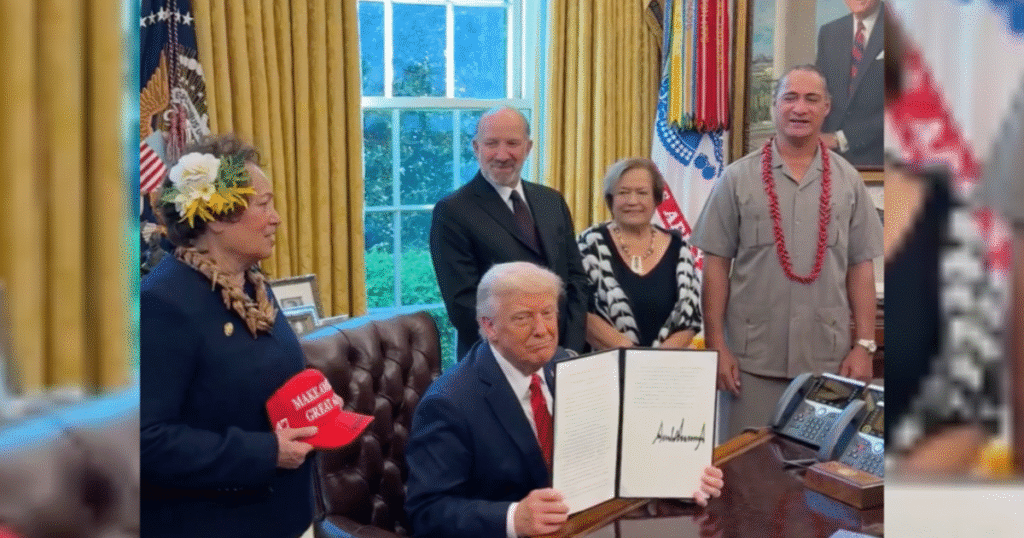President Donald Trump signed two executive orders and a proclamation aimed at reducing regulatory burdens on the U.S. fishing industry, and combating unfair foreign trade practices and reopening 400,000 square miles in the Pacific Ocean to commercial fishing.
The area, previously protected by Presidents George W. Bush and Barack Obama to preserve the marine environment and historic sites around Wake, Baker, Howland, and Jarvis Islands, Johnston and Palmyra Atolls, and Kingman Reef, was deemed redundant with existing laws.
Trump’s “Unleashing American Commercial Fishing in the Pacific” proclamation argues that commercial fishing can coexist with ecosystem and wildlife preservation.
After reviewing Proclamations 8336 and 9173, President Trump’s proclamation states that properly managed commercial fishing poses no threat to the scientific and historic objects protected by these decrees, as existing laws already safeguard them.
It notes that nine federal laws protect the area’s vulnerable marine species and habitats, and fisheries like the National Marine Fisheries Service effectively manage fish populations. The earlier bans on commercial fishing are said to have unnecessarily restricted American businesses. The proclamation seeks to reopen nearly half of the U.S. Exclusive Economic Zone in the Pacific Islands to commercial fishing.
Representatives from American Samoa, which has a tuna-dependent economy, joined President Trump in the White House to celebrate and serenade him.
President @realDonaldTrump signs a Proclamation restoring commercial fishing access to over 1/2 million square miles of U.S. waters in the Pacific pic.twitter.com/EJV0yfWQ2P
— Margo Martin (@MargoMartin47) April 17, 2025
Additionally, Restoring American Seafood Competitiveness aims to:
Aims to:
- Promote American Seafood Industry: Aims to enhance U.S. seafood competitiveness by addressing overregulation, unfair trade practices, and a $20 billion trade deficit, with nearly 90% of seafood imported.
- Reduce Regulatory Burdens: Directs the Secretary of Commerce to revise or rescind burdensome regulations within 30 days, involving Regional Fishery Management Councils and public input to streamline fisheries management.
- Combat Illegal Fishing and Unfair Trade: Develops a comprehensive seafood trade strategy within 60 days to counter illegal, unreported, and unregulated (IUU) fishing and unfair practices, including forced labor, via trade negotiations or enforcement.
- Modernize Fisheries Management: Incorporates advanced technology and cooperative research for better data collection and real-time management, while expanding exempted fishing permits to boost opportunities.
- America First Seafood Strategy: Promotes domestic production, marketing, and export of U.S. seafood, alongside educating consumers on health benefits and increasing seafood in nutrition programs.
- Review Marine National Monuments: Within 180 days, assess opening marine monuments to commercial fishing, ensuring consistency with preservation goals.
- Enhance Import Monitoring: Revise the Seafood Import Monitoring Program to focus on high-risk shipments, improve port checks, and use technology to prevent IUU seafood entry.
Members of the American fishing industry celebrated the news.
AP reports:
Fishermen said they see a brighter future thanks to the Trump executive order. The changes represent a “thoughtful, strategic approach” that could be a lifeline to America’s fishermen, said Lisa Wallenda Picard, president and chief executive officer of the National Fisheries Institute in Virginia.
“The EO outlines key actions to benefit every link in the supply chain — from hardworking fishermen to parents who serve their family this nutritious and sustainable protein at home,” Wallenda Picard said. “Importantly, the order calls for reducing unnecessary regulatory burdens on fishermen and seafood producers while also promoting the many benefits of eating seafood as part of a healthy, balanced diet.”
Read the full article here


